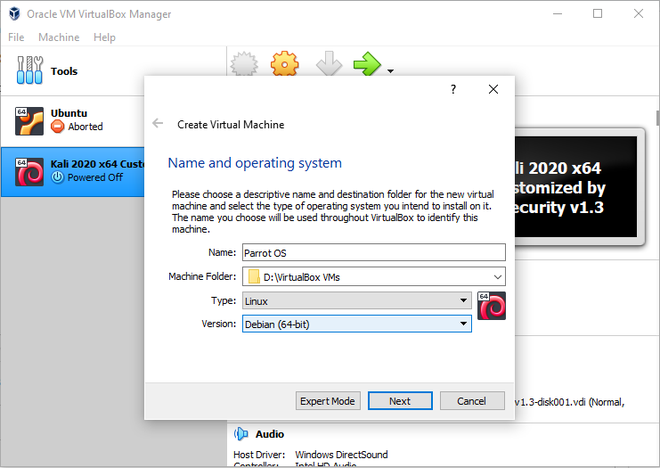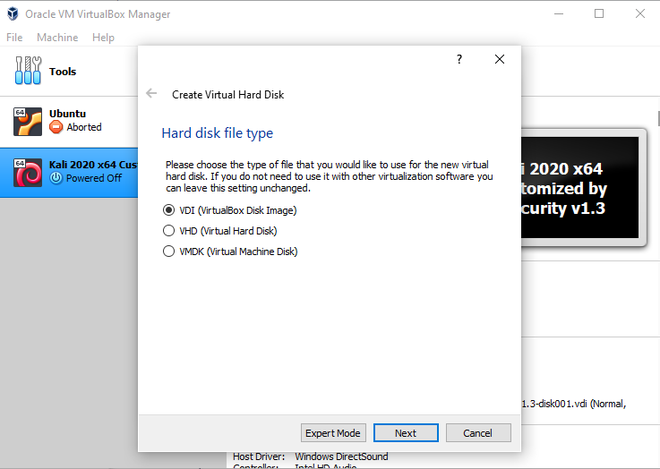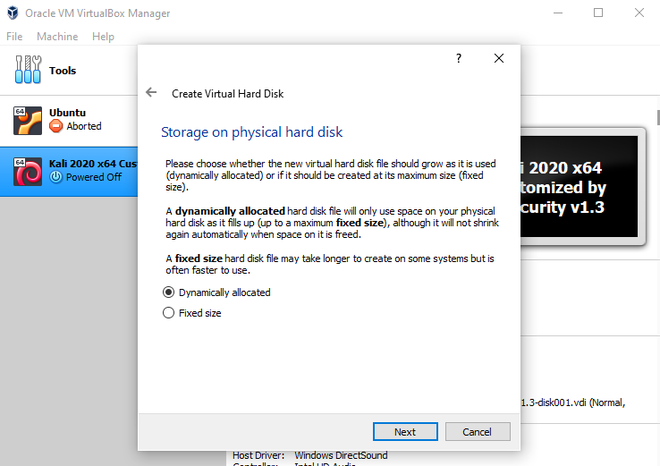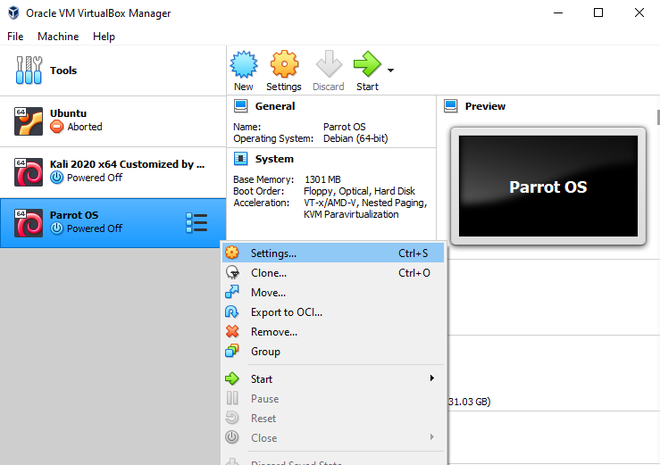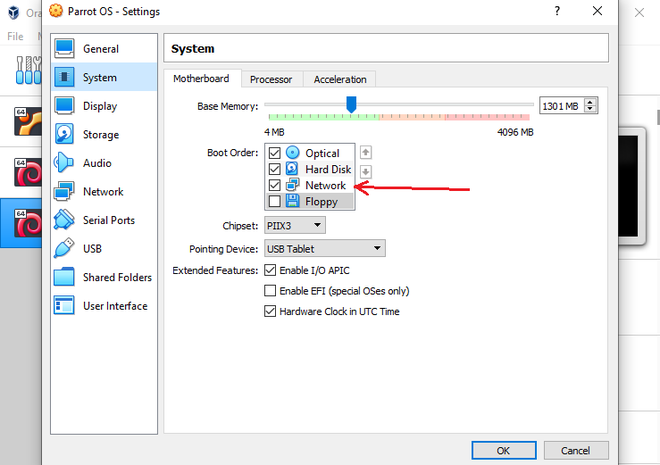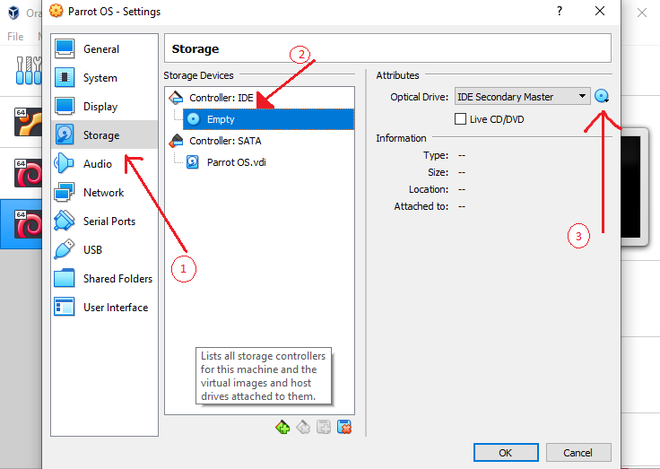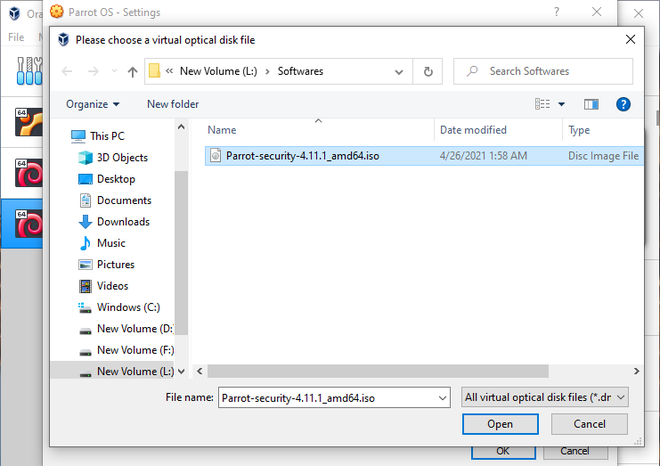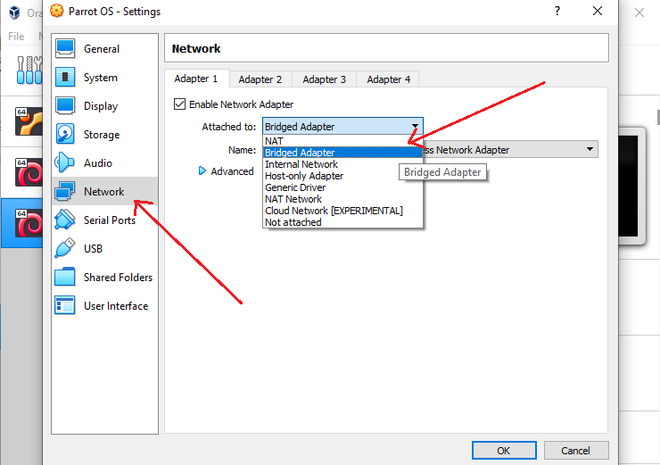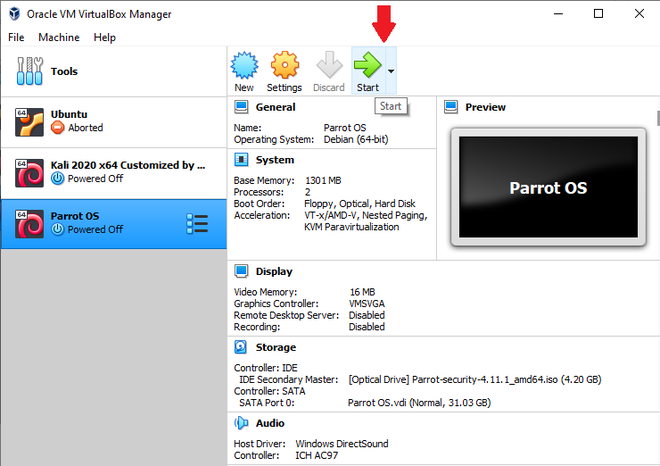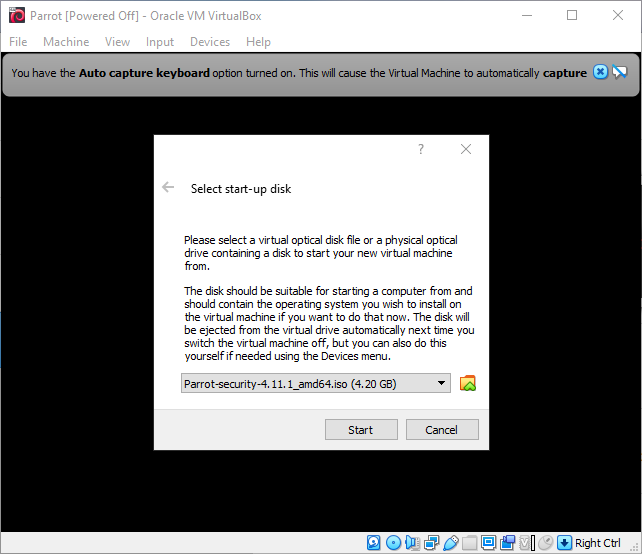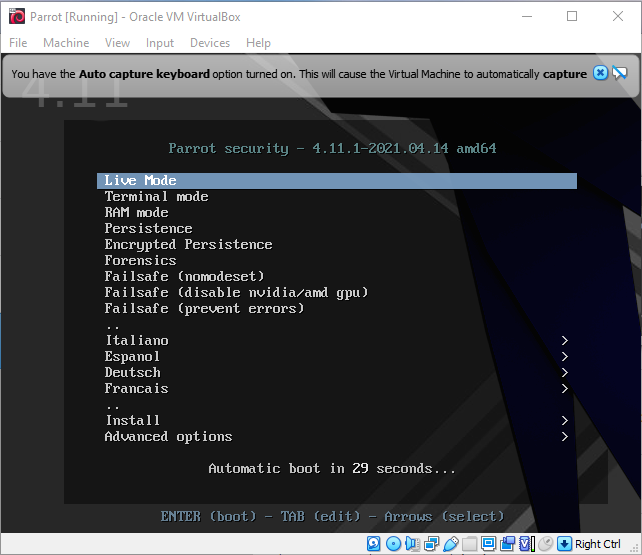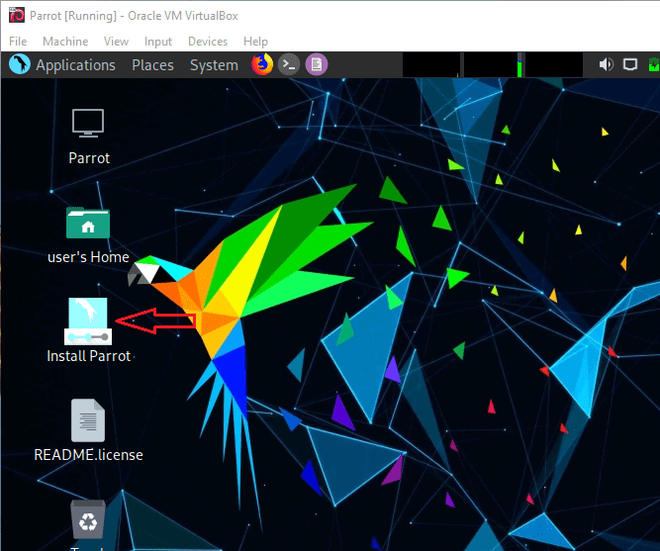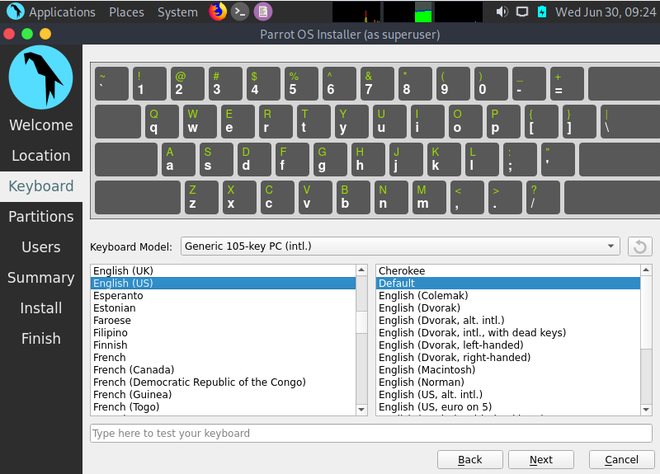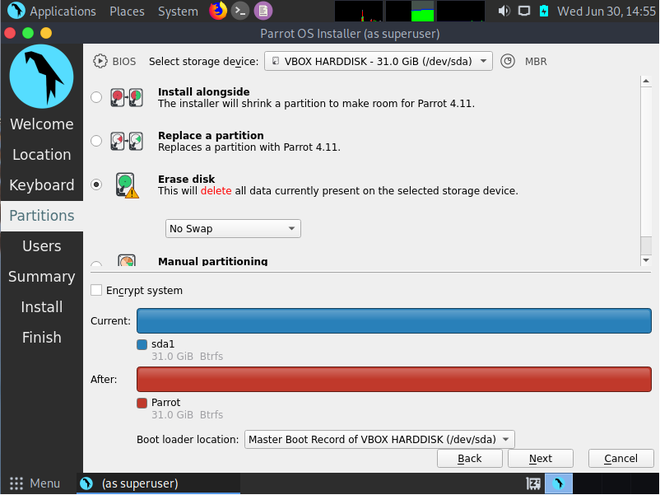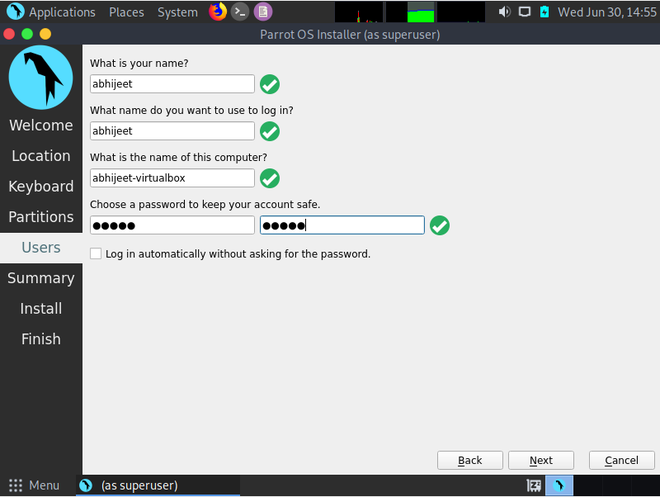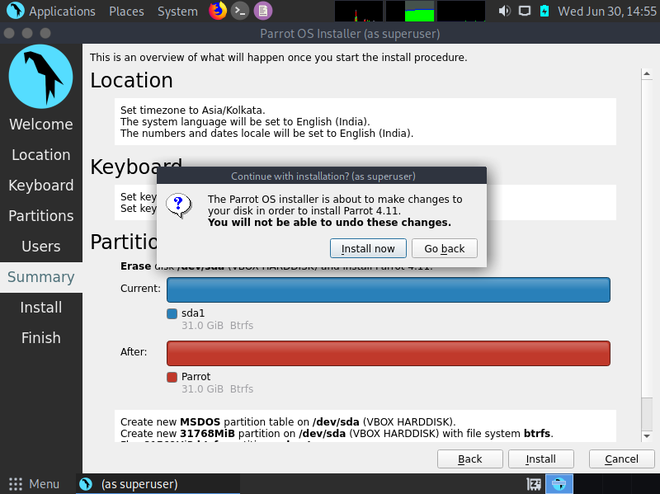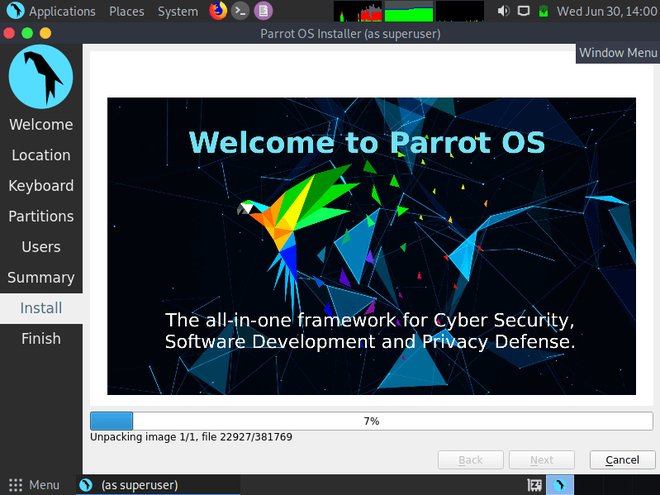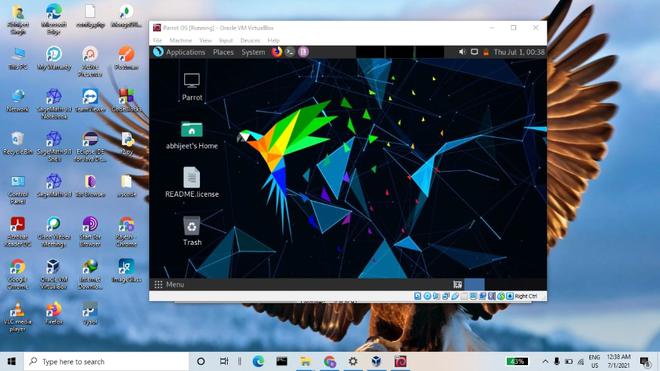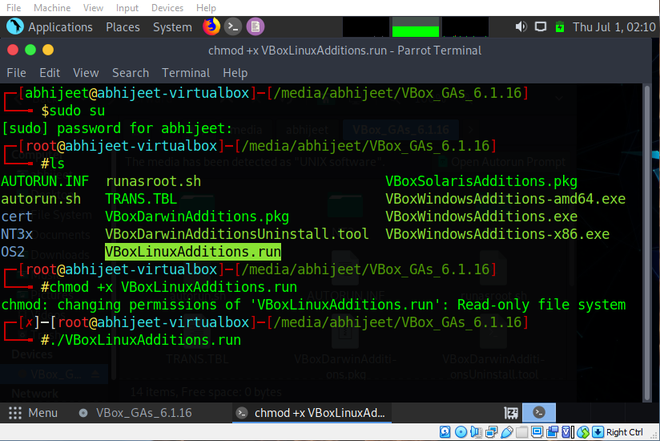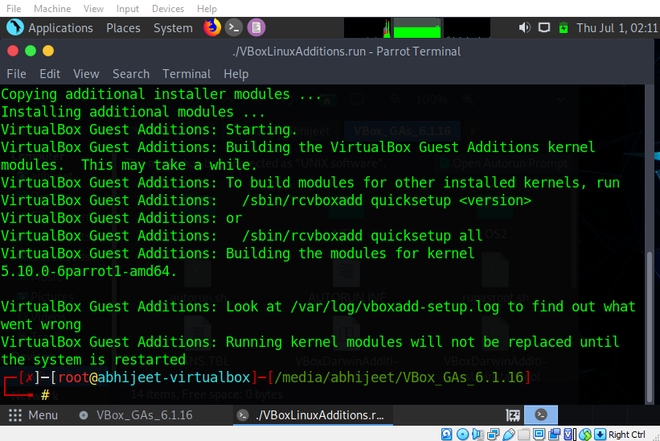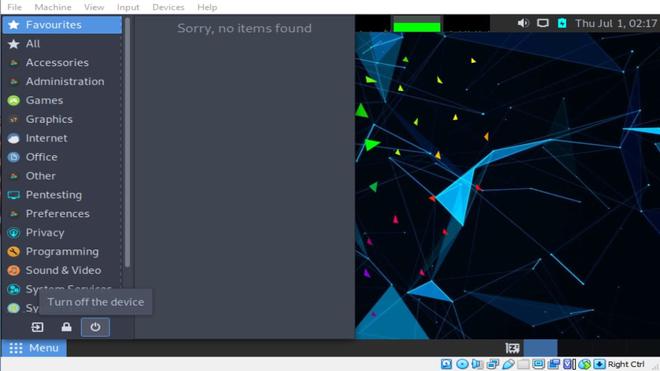- How to Install Parrot OS in VirtualBox?
- Parrot Documentation
- This guide will cover the following steps:
- Things you need to install
- Step 1 — Create a new Virtual Machine
- Step 1.1 — Enter a name for your Virtual Machine
- Step 1.2 — Allocate Memory/RAM
- Step 2 — Create a Virtual Hard Drive
- Step 2.1 — Select Virtual Drive File type
- Step 2.2 — Select Physical Hard Drive allocation type
- Step 2.3 — Allocate disk size
- Step 3 — Modify VirtualBox settings
- Step 3.1 — Select type of OS
- Step 3.2 — Enable shared Clipboard and Drag ’n’ Drop feature
- Step 3.3 — Update Virtual Motherboard options
- Step 3.4 — Select number of Processors and enable PAE/NX
- Step 3.5 — Allocate Video memory and 3D acceleration
- Step 4 — Loading Parrot Security ISO
- Step 4.1 — Select Network connection type
- Step 4.2 — Enable USB 2.0 and 3.0 Controllers
- Step 4.3 — It’s all set up?
- Step 5 — Booting Parrot Security ISO
- Step 5.1 — choose Install
- Step 5.2 — Choose the default Installer (Calamares)
- Step 5.3 — Select language
- Step 5.4 — Select location
- Step 5.5 — Select keyboard layout
- Step 5.6 — Parrot Security disk partitioning
- Step 5.7 — Creating a new user account
- Step 6 Completing the installation process
- Step 7: Login to Parrot Security for the first time
How to Install Parrot OS in VirtualBox?
Parrot OS :
Parrot is similar to Kali Linux, which means it is also used for security purposes and ethical hacking. Similar to Kali, it is also a Linux-based distribution. Now the question arises, which one is better, Kali or Parrot. Both the OS supports 32-bit and 64-bit architecture, supports cloud VPS, support for embedded and IoT devices, and comes pre-installed with an arsenal of hacking tools. So, according to the software perspective, both are roughly different.
When it comes to the hardware, they slightly differ:
| Parrot OS | Kali |
So we can clearly see that on hardware Parrot OS fairly wins because it requires less RAM to work due to its lightweight nature and its installation is pretty easy as well. So, anyone can install Parrot OS, either a beginner or a security professional.
We can also use Parrot OS in dual boot as well, but for a beginner, it is better to install it in VirtualBox so that first they learn how to use Linux commands, learn to use its security tools, and much more. The advantage of using VirtualBox is that if somehow the operating system gets corrupted or crashed, then it won’t harm your base operating system since it is installed in a virtual environment and we can remove it whenever we want.
Prerequisites for Parrot OS :
- At least should have 16GB of free disk space on another OS.
- Parrot OS ISO File that can be downloaded from here
- Install Virtual Box on Windows. Refer to the article – Installing Virtual Box
- Minimum of 5-10 GB free space in your hard disk
- A minimum of 4GB of RAM is recommended, but better to have 8GB for smooth working.
Who Parrot is made for :
- Security Experts
- Digital forensics experts
- Computer Science/Engineering Students
- Researchers
- Wannabe Hackers
- Software developers
- Journalists, Hacktivists, and Whistleblowers
- Police officers and security agencies
For more information on Parrot OS visit its website, here and to learn about its usage you can refer to its documentation.
Install Parrot OS in VirtualBox :
1. Open the virtual box and click on the New Button.
2. Give the name to your virtual machine, add Machine Folder, Type=Linux, and version as Debian (64-bit).Click on next.
A machine folder is the location where the instance of your virtual os is saved. You don’t need to provide it, it will select its default location automatically.
3. Now, to allot the RAM size for a virtual machine, if you have 4GB RAM, give a Memory Size of 15045MB RAM at least so that your virtual machine, as well as your local machine both, can work smoothly. For 8GB RAM and above can give a memory size of 2048MB to 4096MB. Click on next.
4. Select the option “Create a virtual hard disk now” and then click on Create button.
5. Now select the hard disk type for Virtual Hard Disk(For daily purposes it’s better to choose VDI). Click on Next
6. Now select dynamically allocated space for storage on the physical hard disk.
7. Give the size to virtual hard disk, recommended size is 20GB but you can give greater than it also. The location should be kept as default. Now click on Create button.
8. As soon as the process is completed, right-click on the machine name that you created and open Settings.
9. In the Settings window on the left pane, select System, and in Motherboard click on the Network option in the Boot order to enable it.
10. In the Processor section give 2 processors for smooth performance.
11. Again in the left pane, click on the Storage option and then select the “Empty” option given under “Controller: IDE” in the middle pane and then click on the CD image given on the right pane on the right side of “Optical drive”.
It is marked with the sequence of 1,2 and 3 in the figure given below.
12. Click on choose a disk file and navigate it to the location where the Parrot OS ISO image you have downloaded. Then click on Open
13. In the Network section in the left pane select Bridged Adapter to use the internet in your virtual machine. It is of no use if you can’t access the net on your virtual device. Now click on OK at the Bottom.
14. Now all the settings are done and ISO location is provided. Click on start to begin the installation.
15. There are two ways to install first by selecting the Live Mode and 2nd by selecting the Install option and both will work the same. we will go with the 1st method
Select the Parrot OS in Left Pane and click on start for installation.
16. As soon as the installation starts, it prompts you to select the ISO file which you want to install since we have already given its path in settings. We can see the selected iso image, so click on the start button to launch the installation.
17. Click on Live Mode. It will directly start your Parrot OS and you can see its home screen. From there we can proceed with the installation.
18. In its home screen, Select Install Parrot to begin the installation.
18. Provide your location. Click on Next.
19. Select the default language according to your keyboard( below is selected for QUERTY keyboard layout.
20. Click on the “Erase Disk” radio button (recommended for beginners ). It will automatically partition your virtual disk according to the size you have provided to it. Click on Next.
21. Finally, you just need to create a user( root user) and password to access it whenever you want so that your data is saved.
22. On the last page, it will show all the settings that you have selected or done till now so that you can verify it one last time before the final install procedure starts.
23. After verification, if you are not satisfied and change some settings then you can either click on the Back button or click on the Cancel button. If satisfied, then click on the Install button, it will prompt you to continue installation, then click on Install Now, to begin the installation.
24. Now we just need to wait for at least 20-30 minutes for the installation to finish up. After it has done, it will prompt to restart. Click on it restart so that your virtual machine will save all the necessary changes that have been made.
25. After restart you will see that it’s not full screen and it’s quite annoying also to work on it. Therefore, to solve such issues, VirtualBox includes Guest Additions iso to install it and make it full screen to enhance its user’s experience.
Resize VirtualBox to Full Screen :
1. Start your Parrot OS virtual machine and click on the “Parrot GNU/Linux” option or do nothing since it will automatically open Parrot GNU/Linux after 5 seconds.
2. login to the system and at the top in the Menu bar, click in Devices and select “Insert Guest Additions CD image”. This will add Guest Additions iso image for your Linux distribution that helps it to fit in the screen.
3. Now open the folder path “/media/ /” to reach the folder location where this image is added( user-name is the name that you provided while creating the user during installation).
4. Right-click on the page and select “Open in Terminal”.
Now we run a few commands to install Guest Additions and it will enable full-screen mode to your virtual machine.
Command –
$ sudo su
It will prompt you to enter your password:
( password text is hidden so don’t panic) then click enter.
By this way, you become a root user
5. change the mode of file “VBoxLinuxAdditions.run” to executable and then run the file to install Guest Additions.
Command –
# chmod +x VBoxLinuxAdditions.run
it will change the mode of the above file to executable.
# ./VBoxLinuxAdditions.run
It will install Guest Additions
6. After installation is completed to apply the changes, restart your virtual machine.
7. After restarting, to make your virtual machine full screen either click on the top right corner. Maximize button or press “Host+F”( host button is CTRL button present in the right bottom ) on the keyboard.
Now Your Parrot OS is successfully installed in VirtualBox with all the basic functionalities that are required. To shut down your Parrot OS, follow step 6, it will automatically close your virtual machine.
Источник
Parrot Documentation
This guide will cover the following steps:
Create a new Virtual Machine
Create a new Virtual disk (VDI, dynamic allocation etc. )
Modifying VirtualBox settings (allocating physical and Video memory, selecting OS Type, CPU acceleration etc.)
Loading Parrot Security ISO
Booting Parrot Security ISO (initial info, location, timezone etc.)
Parrot Security disk partitioning
Finalizing installation and running Parrot Security on VirtualBox.
Things you need to install
If the OS you are using is Windows or MacOS, here is the link to the VirtualBox installer.
On GNU/Linux it is the same, but you can install it via CLI:
Follow the same steps EXACTLY to install and run Parrot via VirtualBox in your machine.
Step 1 — Create a new Virtual Machine
Before proceeding, make sure you have successfully installed VirtualBox. On GNU/Linux you can check this by opening a terminal and typing virtualbox and/or the icon to start VirtualBox will be visible in the menu. For other operating systems there will be a similar icon to start it.
Once you’ve installed VirtualBox:
- Open it.
- Click on New to create a New Virtual Machine.
Step 1.1 — Enter a name for your Virtual Machine
Enter Parrot Security as the name. Set «Type» to Linux, and set «Version» to Other Linux (64-bit).
Step 1.2 — Allocate Memory/RAM
The OS can run on machines with 512 MB of RAM, but at least 2 GB is strongly recommended for both Parrot Security and Home Editions.
Choose the best setting for your machine and click Next.
Step 2 — Create a Virtual Hard Drive
On this screen select Create a virtual hard disk now (2nd option) and click Create.
Step 2.1 — Select Virtual Drive File type
On the next screen select VDI – VirtualBox Disk Image as your Hard drive file type.
Click Next.
Step 2.2 — Select Physical Hard Drive allocation type
Select Dynamically Allocated and click Next on Storage on physical hard drive window.
Step 2.3 — Allocate disk size
On File location and size screen, it will show 8.00 GB as the default size (which we’ve set on Step 1.1). In this example we have increased it to 20 GB for storage reasons.
Choose which fits your needs and click Next.
Step 3 — Modify VirtualBox settings
So far, we’ve done the following, checklist for you:
- Created a New Virtual Machine
- Created Virtual Hard disk
- Fiddled with disk properties, type and size.
At this point you should see the following screen:
Step 3.1 — Select type of OS
Depending on which ISO you downloaded, select the correct Version here.
As Parrot Security is derived from Debian, I’ve selected Other Linux (64-bit) on General > Basic.
Step 3.2 — Enable shared Clipboard and Drag ’n’ Drop feature
Select General > Advanced TAB and change Shared Clipboard and Drag ’n’ Drop to Bidirectional. This will allow you to copy paste files from your HOST machine on the fly. Confirm by clicking OK.
Step 3.3 — Update Virtual Motherboard options
Select System > Motherboard, un-check Floppy (who has a floppy anymore?) and check the box to Enable I/O APIC.
Note that you can change base memory allocation in the same screen. We’ve set it to 2048 MB previously. If your machine got 8.00 GB RAM, it means that you can allocate a lot more to make Parrot Security respond faster as a virtual machine.
If you feel your Virtualized Parrot Security is slow, you should increase this Base Memory allocation.
The calculations are as follows:
- 1.00 GB = 1024 MB
- 2.00 GB = 2048 MB
- 3.00 GB = 3072 MB
- 4.00 GB = 4096 MB
and so on.
Multiply 1024 with the amount of Memory/RAM you want and put the value here.
Step 3.4 — Select number of Processors and enable PAE/NX
Sets the number of virtual CPU cores the guest OS can see. 2 virtual cores works well. With 4, 6, and so on, performance will be much better.
You should not configure virtual machines to use more CPU cores than are available physically. This includes real cores, with no hyperthreads. See processor tab on VirtualBox website.
Check the box for Enable PAE/NX.
Step 3.5 — Allocate Video memory and 3D acceleration
Select Display > Screen > set Video Memory to 128 MB. This allows for a good responsive desktop environment.
Also check the box for Enable 3D Acceleration.
If you have more than one monitor, you can change your settings here too.
Step 4 — Loading Parrot Security ISO
Select Storage > Controller: IDE and highlight Empty CD icon. Now on your right, you should be able to click on the little CD icon (it should be CD/DVD Drive: IDE Secondary Master already, if not change it) and select your downloaded ISO.
Once you select your downloaded ISO (in this case, it’s Parrot Security 4.11.2 ISO). See the properties and information’s changes accordingly.
Important: if your disk size is mismatched, you might have a corrupt disk. Refer to Parrot Security chapter through this documentation for size related info. You can also do a SHA1 check to ensure your disk is not corrupted.
Note: if you want to test Parrot in live mode, check the «Live CD/DVD» box
Step 4.1 — Select Network connection type
If your computer is connected to the internet, select NAT on Network > Adapter 1. You can enable more network adapters if you feel you want to do so.
Step 4.2 — Enable USB 2.0 and 3.0 Controllers
Firstly, make sure you have installed the extension pack, or you will not be able to enable USB 2.0 and 3.0 controllers.
If you have not installed it, you can download it here
Then go to files > preferences > extensions, on the right there will be a + button where you can install the extension.
In GNU/Linux, you could also install it from the terminal with sudo apt install virtualbox-ext-pack
Once installed, it will enable VirtualBox Remote Desktop Protocol (VRDP) support and Host webcam passthrough support.
Step 4.3 — It’s all set up?
Finally, by clicking on your new virtual machine, this is what you should see:
You can always change the configuration the way you prefer.
Step 5 — Booting Parrot Security ISO
From VirtualBox Main Screen, click on Start and boot Parrot Security.
Step 5.1 — choose Install
From VirtualBox Main Screen, it will boot Parrot Security, click in the Virtual Machine, select Try/Install and then click Enter.
Step 5.2 — Choose the default Installer (Calamares)
Here you can test the OS in its entirety, then you can proceed with the installation.
Click on Install Parrot:
and the default installer, Calamares, will start.
Step 5.3 — Select language
In this example we have chosen American English. Click on Next.
Step 5.4 — Select location
Here we have selected America and New York zone. Click on Next.
Step 5.5 — Select keyboard layout
Select the layout that best suits your keyboard, you can also test the keyboard’s key where it says type here to test your keyboard. Click on Next.
Step 5.6 — Parrot Security disk partitioning
As this is all Virtualized, you can choose anything you want to.
We think that guided partitioning for less experienced users is recommended, 40 GB or more are enough, unless you are going to install a lot more programs or keep more files on your hard drive.
If you want, you can also encrypt the system by adding a passphrase:
Step 5.7 — Creating a new user account
You will be asked to create a new user, for simplicity we have chosen a user. You can enter any name in here.
Then, click on Next
Step 6 Completing the installation process
Finally, a summary of the choices made during the procedure:
You can decide whether to change the chosen settings, and then go back, or proceed with the installation of the system. Click on Install.
Confirm by clicking Install now
And wait for the installation to complete!
With an SSD (Sata), it takes a few minutes.
Well done! You have successfully installed ParrotOS on your computer!
Step 7: Login to Parrot Security for the first time
Enter your Password:
You just installed Parrot Security! Congrats!
Источник

